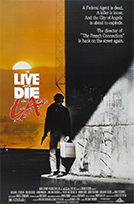To Live and Die in L.A

| Original title: | To Live and Die in L.A |
| Director: | William Friedkin |
| Release: | Cinema |
| Running time: | 116 minutes |
| Release date: | 01 november 1985 |
| Rating: |
Mulder's Review
A tribute to William Friedkin
In the neon-drenched streets of 1980s Los Angeles, where glitz and glamour coexist with the shadows of crime and corruption, William Friedkin's To Live and Die in L.A. takes viewers on a heart-pounding journey through a world where the line between law enforcement and lawlessness blurs into an electrifying shade of gray. As the director of iconic films like The French Connection and The Exorcist, Friedkin brings his signature edginess to a crime thriller that not only captures the pulse of a city but also subverts expectations in a way that has become his hallmark.
The film opens with a jaw-dropping sequence as Secret Service agents Richard Chance (William L. Petersen) and Jimmy Hart (Michael Greene) thwart a terrorist attack on a presidential motorcade. With explosions and rooftop standoffs, Friedkin establishes the film's gritty and intense tone right from the start. However, it's not long before the plot shifts focus to the labyrinthine world of counterfeit currency and the dangerous allure of the criminal underworld.
Chance, haunted by the death of his partner Hart, becomes consumed by an all-encompassing obsession to avenge his friend's murder. His quest leads him to the charismatic counterfeiter Eric Masters (Willem Dafoe), whose chilling charisma and avant-garde style mask a lethal and calculating criminal mind. Dafoe's portrayal of Masters is a revelation, capturing the character's eerie charm and sinister complexity with captivating intensity.
As Chance descends further into the dark and murky realm of counterfeiters and crooks, he becomes entangled with the enigmatic Ruth Lanier (Darlanne Fluegel), a former lover of Masters who may hold the key to dismantling his criminal empire. This relationship adds layers of intrigue and ambiguity to the narrative, as Ruth's motivations remain uncertain and her loyalty shrouded in mystery.
While the central narrative revolves around a battle of wits between law enforcement and criminality, To Live and Die in L.A. thrives on its exploration of duality and moral ambiguity. Friedkin expertly blurs the lines between hero and anti-hero, forcing audiences to confront the ethical complexity of the characters' actions. This moral murkiness is epitomized by Chance himself, whose relentless pursuit of justice often pushes him to bend or break the very laws he is sworn to uphold.
However, it's not just the narrative and characters that make To Live and Die in L.A. a compelling and enduring film. Robby Müller's cinematography brings the cityscape to life, capturing both the vibrant energy and the ominous underbelly of Los Angeles. The film's visual language elevates the atmosphere, creating a neon-soaked neo-noir aesthetic that is as visually striking as it is thematically resonant.
Of course, no discussion of To Live and Die in L.A. would be complete without mentioning its iconic car chase sequence. Set on the city's sprawling freeway system, the chase defies conventions by sending our protagonists against the flow of traffic. The result is a heart-pounding, white-knuckle pursuit that has rightfully earned its place among the pantheon of cinematic chase scenes. It's a masterclass in tension, choreography, and editing, showcasing Friedkin's unparalleled ability to craft high-stakes action.
As the film hurtles toward its stunning conclusion, it doesn't shy away from embracing the unpredictable and challenging the familiar. To Live and Die in L.A. culminates in a climax that defies genre norms, leaving audiences with a sense of uncertainty and complexity that lingers long after the final frame.
To Live and Die in L.A. is a multi-layered cinematic experience that defies easy categorization. It's a gritty crime thriller that delves into the dark underbelly of a city, an exploration of moral ambiguity and obsession, and a visual feast that captures the neon-lit spirit of 1980s Los Angeles. William Friedkin's directorial prowess shines through every frame, pushing the boundaries of the genre and delivering a film that remains a captivating and thought-provoking masterpiece.
Police Fédérale , Los Angeles (To Live and Die in L.A)
Directed by William Friedkin
Written by William Friedkin, Gerald Petievich
Based on Police Fédérale , Los Angeles (To Live and Die in L.A) by Gerald Petievich
Produced by Irving H. Levin, Bud S. Smith
Starring William Petersen, Willem Dafoe, John Pankow, Debra Feuer, John Turturro, Darlanne Fluegel, Dean Stockwell
Cinematography : Robby Müller
Edited by M. Scott Smith
Music by Wang Chung
Production companies : New Century Productions, United Artists, SLM Production Group
Distributed by MGM/UA Entertainment Co.
Release date : November 1, 1985 (United States), May 7 1986 (France)
Running time : 116 minutes
Viewed on August 10, 2023 (video)
Mulder's Mark:

